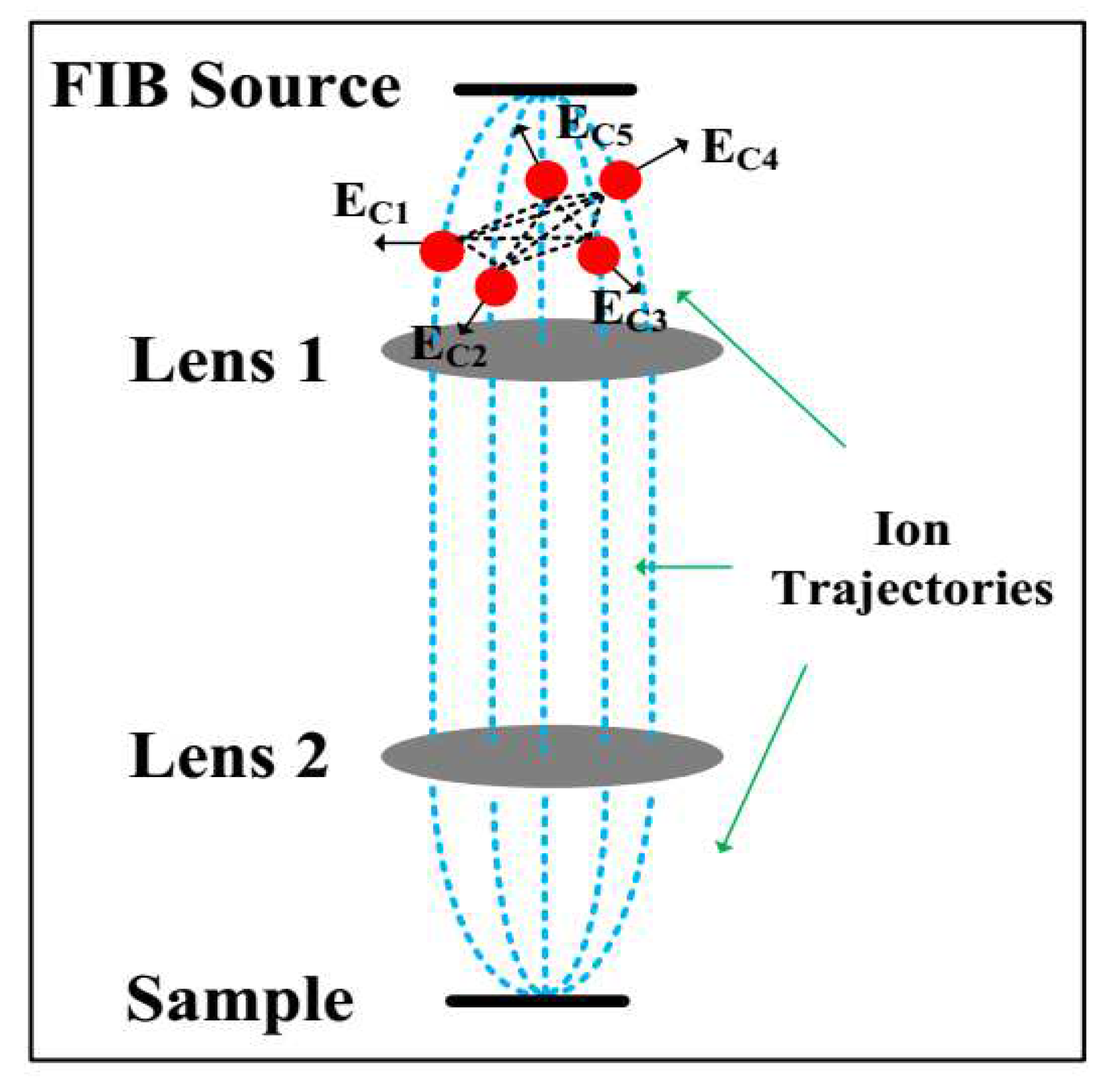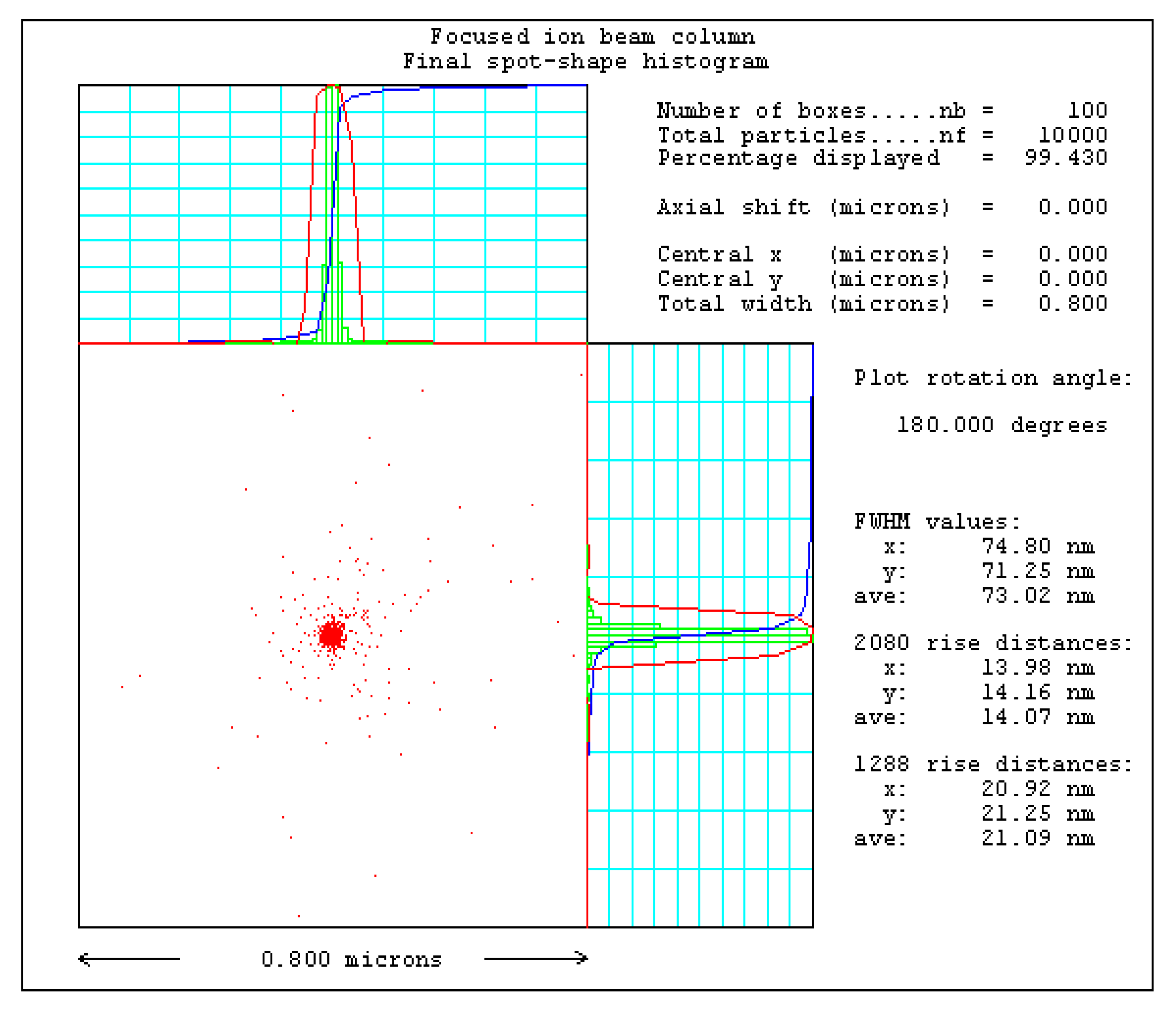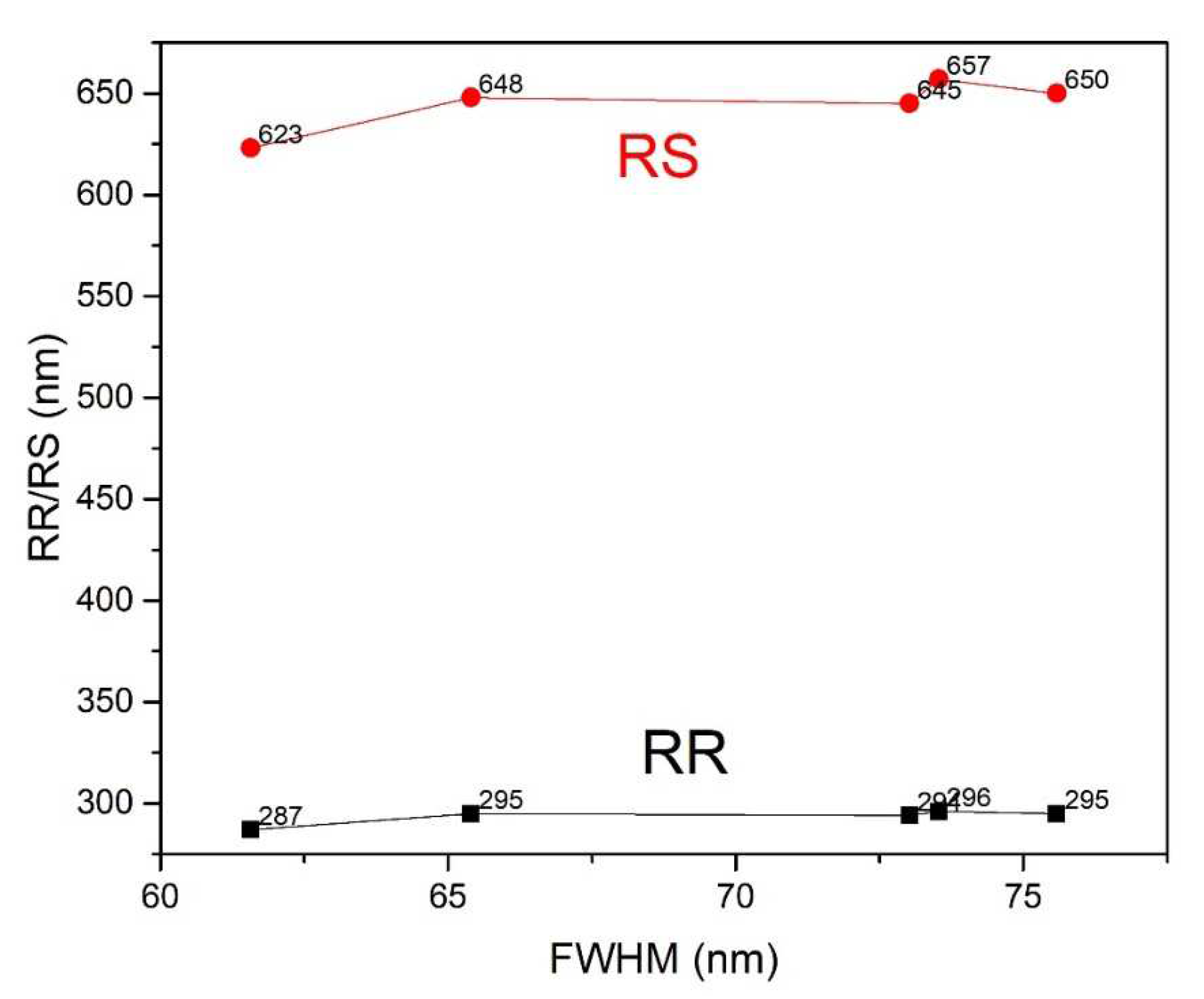3-D SRIM Simulation of Focused Ion Beam Sputtering with an Application-Oriented Incident Beam Model
Abstract
:1. Introduction
2. Theory on Ion-Solid Interaction
3. Application-Oriented Model of Incident Beam
4. Results
4.1. Simulation Results
4.2. Experimental Results
5. Conclusions
Author Contributions
Funding
Conflicts of Interest
References
- Krohn, V.E.; Ringo, G.R. Ion source of high brightness using liquid metal. Appl. Phys. Lett. 1975, 27, 479. [Google Scholar] [CrossRef]
- Gierak, J. Focused ion beam technology and ultimate applications. Semicond. Sci. Technol. 2009, 24, 043001. [Google Scholar] [CrossRef]
- Kim, C.S.; Ahn, S.H.; Jang, D.Y. Review: Developments in micro/nanoscale fabrication by focused ion beams. Vacuum 2012, 86, 1014–1035. [Google Scholar] [CrossRef]
- Bassim, N.; Scott, K.; Giannuzzi, L.A. Recent advances in focused ion beam technology and applications. MRS Bull. 2014, 39, 317–325. [Google Scholar] [CrossRef]
- Orloff, J. High-resolution focused ion beams. Rev. Sci. Instrum. 1993, 64, 1105. [Google Scholar] [CrossRef]
- Volkert, C.A.; Minor, A.M. Focused ion beam microscopy and micromachining. MRS Bull. 2007, 32, 389–395. [Google Scholar] [CrossRef]
- Nalla, R.K.; Porter, A.E.; Daraio, C.; Minor, A.M.; Radmilovic, V.; Stach, E.A.; Tomsia, A.P.; Ritchie, R.O. Ultrastructural examination of dentin using focused ion-beam cross-sectioning and transmission electron microscopy. Micron 2005, 36, 672–680. [Google Scholar] [CrossRef]
- Mayer, J.; Giannuzzi, L.A.; Kamino, T.; Michael, J. TEM sample preparation and FIB-induced damage. MRS Bull. 2007, 32, 400–407. [Google Scholar] [CrossRef]
- Ciobanu, C.L.; Cook, N.J.; Utsunomiya, S.; Pring, A.; Green, L. Focussed ion beam–transmission electron microscopy applications in ore mineralogy: Bridging micro- and nanoscale observations. Ore. Geol. Rev. 2011, 42, 6–31. [Google Scholar] [CrossRef]
- Clancy, M.; Pomeroy, M.J.; Belochapkine, S. Improved FIB milling process for TEM preparation of NiAlPt bulk alloy samples containing residual stress. Micron 2012, 43, 627–630. [Google Scholar] [CrossRef]
- Tseng, A.A. Recent developments in micromilling using focused ion beam technology. J. Micromech. Microeng. 2004, 14, R15–R34. [Google Scholar] [CrossRef]
- Ahn, S.H.; Yoon, H.S.; Jang, K.H.; Kim, E.S.; Lee, H.T.; Lee, G.Y.; Kim, C.S.; Cha, S.W. Nanoscale 3D printing process using aerodynamically focused nanoparticle (AFN) printing, micro-machining, and focused ion beam (FIB). CIRP Ann. 2015, 64, 523–526. [Google Scholar] [CrossRef]
- Prosa, T.J.; Larson, D.J. Modern Focused-Ion-Beam-Based Site-Specific Specimen Preparation for Atom Probe Tomography. Microsc. Microanal. 2017, 23, 194–209. [Google Scholar] [CrossRef] [PubMed]
- Gerlach, R.; Utlaut, M. Focused ion beam methods of nanofabrication: Room at the bottom. Charg. Part. Detect. Diagn. Imaging 2001, 4510, 96–106. [Google Scholar]
- Lepinay, K.; Lorut, F. Three-Dimensional Semiconductor Device Investigation Using Focused Ion Beam and Scanning Electron Microscopy Imaging (FIB/SEM Tomography). Microsc. Microanal. 2013, 19, 85–92. [Google Scholar] [CrossRef]
- Holzer, L.; Wiedenmann, D.; Munch, B.; Keller, L.; Prestat, M.; Gasser, P.; Robertson, I.; Grobety, B. The influence of constrictivity on the effective transport properties of porous layers in electrolysis and fuel cells. J. Mater. Sci. 2013, 48, 2934–2952. [Google Scholar] [CrossRef]
- Ziegler, J.; Biersack, J.P.; Ziegler, M.D. Ion Straggle and TRIM: Output Files. In The Stopping and Range of Ions in Matter; Springer: Boston, MA, USA, 2008. [Google Scholar]
- Drobny, J.; Curreli, D. F-TRIDYN simulations of tungsten self-sputtering and applications to coupling plasma and material codes. Comp. Mater. Sci. 2018, 149, 301–306. [Google Scholar] [CrossRef]
- Mutke, A.; Schneider, R.; Bandelow, G. SDTrimSP-2D: Simulation of particles Bombarding on a Two Dimensional Target (Version 2.0)(IPP 12/11); Max-Planck-Institut für Plasmaphysik: Garching, Germany, 2013. [Google Scholar]
- Hofsass, H.; Zhang, K.; Mutzke, A. Simulation of ion beam sputtering with SDTrimSP, TRIDYN and SRIM. Appl. Surf. Sci. 2014, 310, 134–141. [Google Scholar] [CrossRef]
- Schmied, R.; Froch, J.E.; Orthacker, A.; Hobisch, J.; Trimmel, G.; Plank, H. A combined approach to predict spatial temperature evolution and its consequences during FIB processing of soft matter. Phys. Chem. Chem. Phys. 2014, 310, 6153–6158. [Google Scholar] [CrossRef]
- Von Toussaint, U.; Mutzke, A.; Manhard, A. Sputtering of rough surfaces: A 3D simulation study. Phys. Scr. 2017, 170, 014056. [Google Scholar] [CrossRef]
- Ali, M.Y.; Hung, N.P.; Ngoi, B.K.A.; Yuan, S. Sidewall surface roughness of sputtered silicon I: Surface modelling. Surf. Eng. 2003, 19, 97–103. [Google Scholar] [CrossRef]
- Ali, M.Y.; Hung, N.P.; Ngoi, B.K.A.; Yuan, S. Sidewall surface roughness of sputtered silicon II: Model verification. Surf. Eng. 2003, 19, 104–108. [Google Scholar] [CrossRef]
- Orloff, J. Resolution. In Handbook of Charged Particle Optics; CRC Press: Boca Raton, FL, USA, 1997; pp. 392–434. [Google Scholar]
- Lugstein, A.; Basnar, B.; Hobler, G.; Bertagnolli, E. Current density profile extraction of focused ion beams based on atomic force microscopy contour profiling of nanodots. J. Appl. Phys. 2002, 92, 4037–4042. [Google Scholar] [CrossRef]
- Marianowski, K.; Ohnweiler, T.; Plies, E. Coulomb interactions in a low-voltage focussed ion beam system. Nucl. Instr. Methods Phys. Res. Sect. 2011, 645, 116–119. [Google Scholar] [CrossRef]
- Shorubalko, I.; Choi, K.; Stiefel, M.; Park, H.G. Ion beam profiling from the interaction with a freestanding 2D layer. Beilstein J. Nanotechnol. 2017, 8, 682–687. [Google Scholar] [CrossRef] [PubMed]
- Nassar, R. Mathematical modeling of focused ion beam microfabrication. J. Vac. Sci. Technol. B 1998, 16, 109. [Google Scholar] [CrossRef]
- Ali, M.Y.; Hung, W.; Fu, Y.Q. A Review of Focused Ion Beam Sputtering. Int. J. Precis. Eng. Manuf. 2010, 11, 157–170. [Google Scholar] [CrossRef]
- Munro, E.; Rouse, J.; Liu, H.; Wang, L.; Zhu, X. Simulation software for designing electron and ion beam equipment. Microelectron. Eng. 2006, 83, 994–1002. [Google Scholar] [CrossRef]
- Munro, E.; Rouse, J.; Liu, H.; Wang, L.; Zhu, X.; Wang, J.B.; Wang, Y.L. A novel procedure for measuring the absolute current density profile of a focused gallium-ion beam. Appl. Phys. Lett. 1996, 69, 2764–2766. [Google Scholar]
- Hung, N.P.; Fu, Y.Q.; Ali, M.Y. Focused ion beam machining of silicon. J. Mater. Process. Technol. 2002, 127, 256–260. [Google Scholar] [CrossRef]







| Point-Like Incident | Gaussian Distribution Beam | Application-Oriented Model | |
|---|---|---|---|
| Longitudinal Range | 280 Å | 280 Å | 280 Å |
| Longitudinal Straggle | 103 Å | 104 Å | 104 Å |
| Lateral Proj. Range | 65 Å | 106 Å | 188 Å |
| Lateral Proj. Straggle | 83 Å | 133 Å | 503 Å |
| Radial Range | 102 Å | 166 Å | 296 Å |
| Radial Straggle | 59 Å | 88 Å | 657 Å |
© 2019 by the authors. Licensee MDPI, Basel, Switzerland. This article is an open access article distributed under the terms and conditions of the Creative Commons Attribution (CC BY) license (http://creativecommons.org/licenses/by/4.0/).
Share and Cite
Zhao, L.; Cui, Y.; Li, W.; Khan, W.A.; Ma, Y. 3-D SRIM Simulation of Focused Ion Beam Sputtering with an Application-Oriented Incident Beam Model. Appl. Sci. 2019, 9, 5133. https://doi.org/10.3390/app9235133
Zhao L, Cui Y, Li W, Khan WA, Ma Y. 3-D SRIM Simulation of Focused Ion Beam Sputtering with an Application-Oriented Incident Beam Model. Applied Sciences. 2019; 9(23):5133. https://doi.org/10.3390/app9235133
Chicago/Turabian StyleZhao, Lirong, Yimin Cui, Wenping Li, Wajid Ali Khan, and Yutian Ma. 2019. "3-D SRIM Simulation of Focused Ion Beam Sputtering with an Application-Oriented Incident Beam Model" Applied Sciences 9, no. 23: 5133. https://doi.org/10.3390/app9235133





